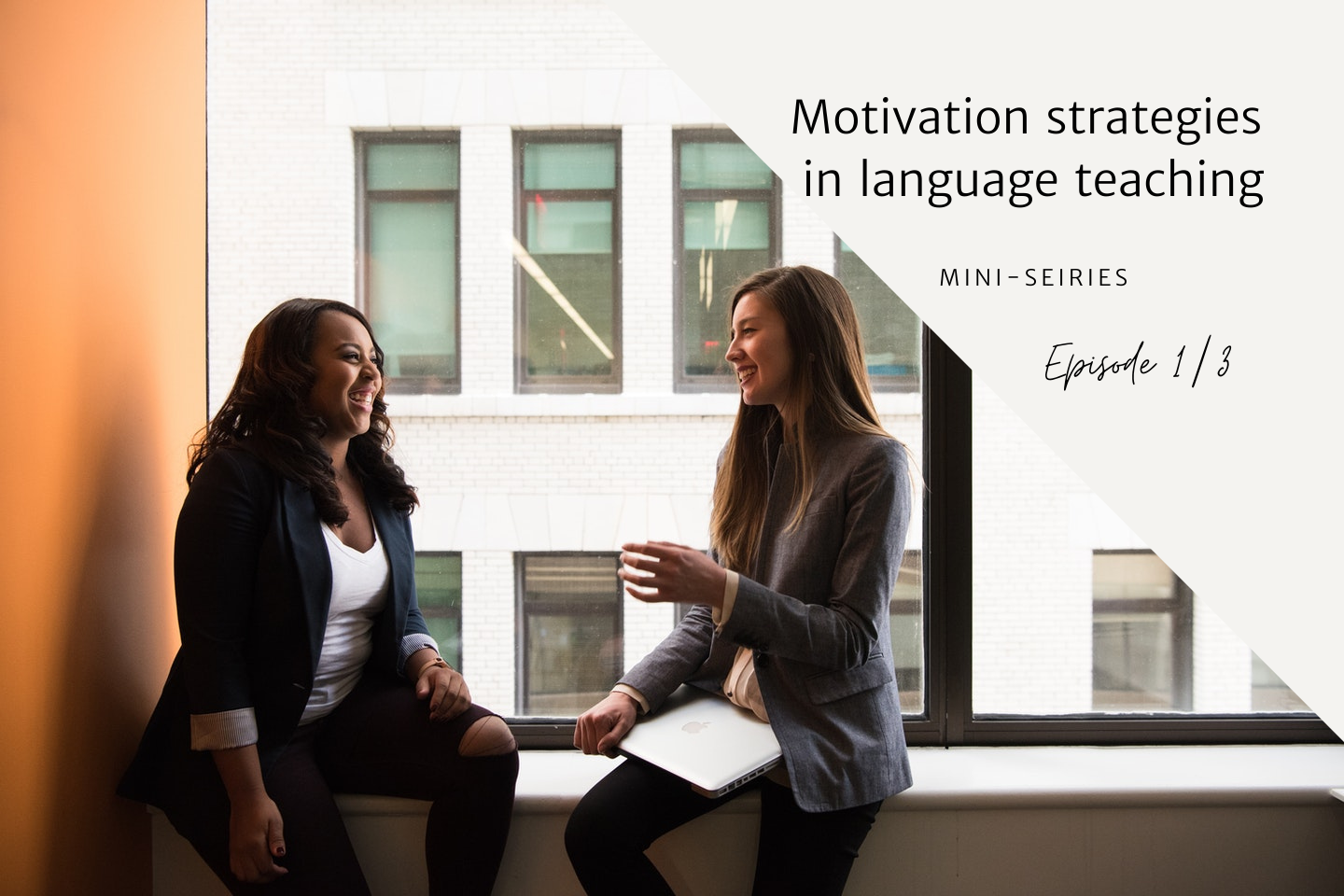
For us, language teachers, motivation is king. It’s a slippery slope, too, though, unless you know a method for addressing your students’ motivation in language learning. Many teachers look for the magic formula inside alternative lessons plans, fun exercises, personalised activities. Those are all valuable tactics that sometimes are winners and sometimes seem not to bring the expected results for all the students. Then, what’s the strategy that stands behind those quick-wins? Is there a method, a framework for taking students to say “I learn English (languages) because I enjoy it!”? In this mini-series of three articles you’re going to learn about that framework, including strategies and practical tips for implementing the guidelines.
Before divining in, I invite you to download the free cheat-sheet and get all the strategies in one place:
I’m kicking off this mini-series of three articles by providing you with the bigger picture about what motivation in language learning is and what motivating students practically means for language teachers. As I like it to say quite often, there is a method for anything – and, yes, there is a method for understanding and making the most out of our students’ motivational triggers, too.
The whole mini-series explores the motivation in language learning topic from the perspective of the Self-Determination Theory (SDT). Now, if you know about SDT already, good on you and you’ll probably find practical tips for implementing the theory into your classes. If you don’t know SDT yet, happy days! This is the perfect chance for settling an important part of your foundations as a language teacher.
Before we dive in, I’d like to make it clear that the goal of this mini-series is to provide language teachers with practical strategies and a better understanding of the guidelines that lead to getting students to speak and engaged. If you want to dig deeper into SDT, then I suggest to follow the resources I linked on this article. Let’s dive in, then.
What’s motivation in language learning?
Motivation is what enables people to take on challenges, to carry out tasks and eventually to achieve results. According to SDA, there are two kinds of motivation:
- Controlled motivation
- Autonomous motivation
What’s controlled motivation?
The first type of motivation is called controlled because it depends on external variables (thoughts, feedback, reactions, circumstances) that deeply affect student’s behaviour when it comes to language learning.
When students behave within the controlled motivation area, they learn because they want:
- a reward
- to avoid a punishment
- to comply with academic requirements
- to comply with job requirements
- to avoid shame or not to seem incompetent in the eyes of classmates, colleagues, peers or teachers
- to seek approval from people (for instance teachers or parents) and to make them feel proud
You know that students’ behaviour belong to controlled motivation when you hear students saying:
- “I’ve been studying English just because it is part of the academic curriculum.”
- “I’m studying Spanish because I have to pass the final test.”
- “I’m studying German because if I fail the final test my parents won’t let me go on holiday abroad.”
- “I’m studying English because my employer wants me to do that.”
- “I’m studying English because all my colleagues are good at speaking English and I feel embarrassed when we work together our international colleagues.”
- “I study French because my parents want it and I don’t want to let them down.”
What’s autonomous motivation?
Autonomous motivation comes from students’ inner awareness. In this case, the behaviour is done because of its personal value and importance. Also, in some cases the behaviour connects with other values and aspects of the students’ identity. A trip abroad to get ready for, a life goal, a desire: those are all examples for autonomous motivation.
You know that students’ behaviour belong to autonomous motivation when you hear students saying:
- “I am studying English because it is important to communicate when in a foreign country.”
- “I’ve been studying Spanish because it’s important for me to be able communicate with my Spanish colleagues in their mother tongue.”
- “I am studying German because it is necessary when living in Germany, which is one of my life goals.”
- “I’m studying French because I want to study at the university in Paris, which is one of my greatest aspirations.”
The most extreme expression of autonomous motivation is called intrinsic motivation. When a behaviour comes from intrinsic motivation, then students learn because they love doing it, for personal enjoyment, interest and fulfilment. You might hear students saying:
- “I am studying English just because I enjoy it.”
- “I am studying Russian because I love everything about Russian culture.”
For me, intrinsic motivation was the trigger that brought me to study Czech at the university: I simply loved everything about Czech history and literature!
Then, what type of motivation is winner?
What’s the target for language teachers?
According to SDT, intrinsic motivation is the target for optimal classroom learning. Teachers ought to work with their students in order to trigger intrinsic motivation. In other words, although some students’ behaviour originates from controlled motivation, teachers need to take them to intrinsic motivation. Why?
Why is intrinsic motivation the target?
Intrinsic motivation is the target in the language classroom because it promotes meaningful learning and triggers real change that potentially lasts forever.
On the contrary, controlled motivations make learning a more difficult, frustrating, and not enjoyable task, both for students and teachers, on the long term.
Is intrinsic motivation always the target?
No, it isn’t, because of three reasons:
- Students may have multiple reasons to learn a language
- The types of motivation can vary depending on the context
- Students react to the different types of motivation according to their age
Motivation in language learning and age
Controlled motivation is the main trigger for children and kids. Studies show intrinsic motivation decreases in the age group 8-14 years old and then it increases in the age group 15-18 years old.
Meaning, on one hand, what keeps children and kids motivated is: rewards, good marks, straightforward feedback by the people students care about.
On the other hand, people in their teens look for autonomy, identity, a role, they don’t like neither control nor pressure. No wonder autonomous motivation is their regulator!
For adults, motivation really depends on a number of variables and it can vary according to the circumstances.
The motivating process is usually a long-term affair; one that is gradually constructed with patience, trust, care, and hard work. It is widely recognized that, particularly, in teaching it is rare to find dramatic motivational events that—like a lighting or a revelation—reshape the students’ mindsets from one moment to another. Rather it is typically a series of nuances that might eventually culminate in a long-lasting effect. (Dörnyei, 2001)
How can language teachers achieve the target?
Teachers should facilitate autonomous motivation to help the students to transform controlled behaviours into autonomous behaviours. How? That’s the true hot questions!
Here is the answer:
- Identify your students’ motivational regulators. Simply ask them: “Why do you study French?”, “Why did you choose to study English?”. According to what they say, you should be able to relate their answers to either controlled or autonomous type-of motivation.
- Give them what they want and connect. You’ll need to connect with their needs and motivational regulator in first place, meaning you’ll give them what keeps them motivated at that specific moment. If their motivational regulator is controlled, for instance, reward their efforts with stickers, prizes, other types of rewarding. If they are learning because they want to feel accepted by others or to make someone else proud of them, then make them feel safe in the relationship with you or with those people. After all, they are manifesting a need for deeper connection with these people. If you try to skip this step and jump to point #3 (see below), they might perceive their needs are not fulfilled. I invite you to download the cheat sheet “Feeding motivation in language learning” to get a complete picture of: the types of motivation, where the behaviours come from and why the behaviour is done, examples, how to feed the different types of motivation (what the students want and how to fulfil those needs). What about the students who seem to be totally demotivated? How can we trigger some kind of motivation? You’ll find answer in the cheat sheet.
- Take them where you want to take them. Start from giving them what they want (see above), but then lead them where you want to take them. Bear in mind you want to address all their efforts in order to trigger intrinsic motivation. That’s the end game. How can you do that? Bear with me until the next episode of this 3-part mini-series dedicated to motivation in language learning. In the next blog post we’re going to explore the specific tactics, what activities to propose, how to give instructions, in order to boost engagement and to turn controlled behaviours into autonomous behaviours.
Conclusions:
Teachers should facilitate autonomous motivation to help the students to transform controlled behaviours into autonomous behaviours and eventually to take them to develop intrinsic motivation.
In fact, intrinsic motivation triggers meaningful learning and helps the students to become fully self-efficient in learning a language as well as to really enjoy language learning.
On the contrary, controlled motivation is weaker and contingent: it lasts for the time the reward is taken or the test is passed. Controlled motivation alone doesn’t bring to enjoyable, fulfilling learning experiences.
Next steps:
Start by identifying your students’ motivational regulators. Get to know your students from this point of view. Afterwards, give them what they want depending on the type of motivation they have at the moment. Then take them where you want to take them: see how to do this in the next episode. Meanwhile, you may find it helpful to download the cheat sheet “Feeding motivation in language learning”.
In the next episode:
In the next post you’re going to learn about the three psychological needs we need to fulfil in order take the students to develop intrinsic motivation. Related to those needs, I’m going to provide you with a list of activities, tips and instructions you can implement straightaway in the classroom.
In the next two posts I’m going to answer the following questions:
- Once we give the students what they want, what shall we do to facilitate autonomous motivation?
- What are the strategies we need to implement in order to take the students to intrinsic motivation?
- Shall we implement those strategies even with students who seem to be totally demotivated?
- Can playful activities, games and drama help?
Catch up in episode #2!
Want more support?
Join the Facebook group Independent Language Teachers Collective to get daily advice, tons of free training and to branch out with other independent language teachers like you!
ALSO…
Available only for the Collective members: free list 103 question for sparking engagement in your language lessons.
This is what members say about the freebie:

Join in the Collective and grab your welcome gift:
Join Facebook Group

